Ian Dickson: Bob Marley, 1975
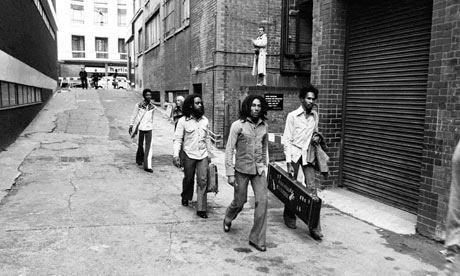 Photograph: Ian Dickson
Photograph: Ian Dickson
Bob Marley was becoming very popular when the NME sent writer Andrew Tyler and me to Birmingham to meet the Wailers on their first British tour.
We arrived at their hotel and introduced ourselves. There was a bit of a nervous "atmosphere" – after all, this was the early days of two cultures meeting through music. But they were friendly and gave short (though barely decipherable) answers to the questions and then invited us to the sound check at the Odeon Theatre in the city centre. "Great, where are the limousines?" we said. The answer: "We got no limousines, we walk!"
So there they were, traipsing along a Birmingham street, dreadlocks flying, all carrying their own gear. I went on ahead to get this shot as they came down the side alley. There are policemen in the background as there had been a fatal stabbing at a reggae club the previous night and the law wasn't taking any chances.
Ray Stevenson: Jimi Hendrix, 1967
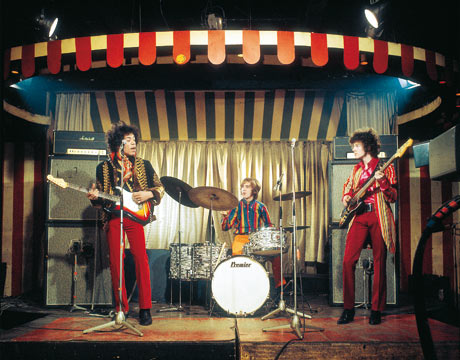 Photograph: Ray Stevenson
Photograph: Ray Stevenson
I had been photographing folk musicians at the Marquee Club, and that afternoon I popped in because I knew the staff there. It turned out Hendrix was sound-checking.
It was very early days for the band and Hendrix's manager, Chas Chandler, was keen to get publicity. I watched one or two songs, and I was a convert. I started photographing almost every gig he had in London. This particular shot was probably a month or two later. Hendrix was back at the Marquee filming a West German TV show called Beat Club.
He was a phenomenal talent. I was astounded. I'd never heard guitar used that way. I could have had 50 naked women behind me and I wouldn't have cared. He was doing impossible things on that guitar. Some people belong in a studio, and some people belong on stage. Hendrix was more interesting on stage.
He was very tall, with enormous great hands which you can kind of see. When I shook hands with him I got lost in there. But he was so gentle. With all that passion and fire on stage, to this very soft-spoken thing. It was a real surprise.
Gered Mankowitz: Marianne Faithfull, 1964
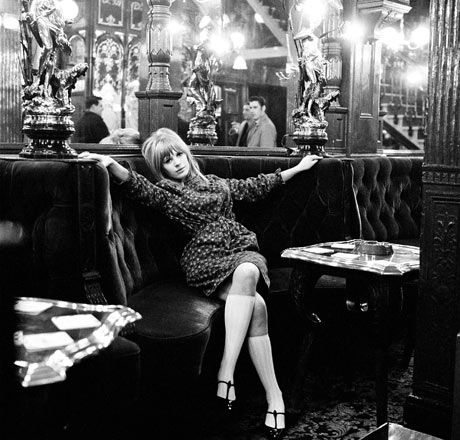 Photograph: Gered Mankowitz ©Bowstir Ltd, 2010/mankowitz.com
Photograph: Gered Mankowitz ©Bowstir Ltd, 2010/mankowitz.com
I met Marianne through a friend, Jeremy Clyde, who sang in the duoChad & Jeremy. We all met for dinner and I immediately fell under her magical spell. She was absolutely adorable; terribly pretty, very funny, lovely to be with, incredibly bright and enjoying it all. We clicked straight away and I asked if I could photograph her.
I thought the Salisbury Pub on St Martin's Lane would make a good location, so I took her there to do photographs for her album cover. The picture was rejected by the record company. They didn't like the guys reflected in the mirrors – they thought it looked leery and she looked too available.
The picture remained one of my all-time favourites of her. Eventually I was able to pull it out for an exhibition and it's proved a huge success. People love her – they love her innocent sexuality. She exudes sexuality, and yet she's completely chaste.
Jill Furmanovsky: Joy Division, 1979
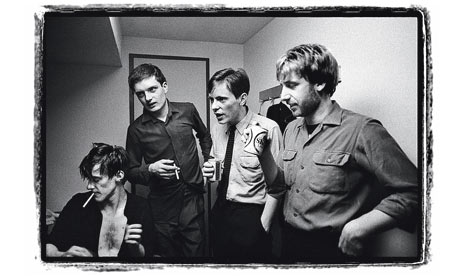 Photograph: Jill Furmanovsky
Photograph: Jill Furmanovsky
It was the first and only time I photographed Joy Division. I was shooting for one of the music press, and after the gig I went into the dressing room and took a few snaps. Nobody took any notice of me. It wasn't like there was a bodyguard at the door. The band at that time were doing quite well, but they weren't selling out stadiums or anything. It was probably a gig of less than 1,000 people. Ian Curtis was quite a cheerful fellow, not gloomy at all. They were just starting out and they were having a good time.
It's not posed. I'm a fairly discreet person. I'd say, "Do you mind if I take a few snaps?" I never spoke to Ian. I'm a photojournalist at heart. They do their thing, I do my thing. When I started shooting, I was only 18 and a nubile young lady. I used to wear baggy black clothes as a disguise. I was trying really hard to be a professional photographer in a fairly male-dominated industry and I didn't want to be mistaken for a groupie.
Laura Levine: REM, 1984
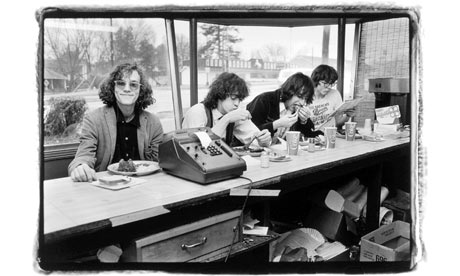 Photograph: Laura Levine
Photograph: Laura Levine
The band were about to release their second album, Reckoning, and as their record label didn't have a budget to send a photographer, I flew down to Athens, Georgia, on my own dime to shoot pictures and spend a few days with my friends. The five of us explored every nook and cranny that had photogenic possibilities – railroad tracks, abandoned factories, roadside signs, RA Miller's whirligig yard and, of course,Walter's Bar-B-Que. Truthfully, we stopped at Walter's because we were hungry. It wasn't a staged shot. While we were eating I saw a great photograph there, so I took it.
I first heard about REM from a friend who handed me their homemade cassette Radio Free Europe/Sitting Still. He thought I might like their music, and he was right. I arranged to do a photo session with them when they came up to play New York City in 1982 for the New York Rocker, where I was chief photographer and photo editor.
I photographed REM more than any other band – and probably more than any other photographer – in a four-year span. They were still coming up at the time: on a small record label, playing clubs, driving their own van and sleeping on floors. I could sense they were on their way to even greater success, and the photojournalist in me wanted to document that process. I often travelled with them, photographing them backstage, on stage, in motel rooms and at home.
Michael, Peter, Bill and Mike were some of the easiest and most agreeable guys I've ever worked with. I think the fact that we were all friends brought an extra level of fun and trust to a process that can sometimes, I realise, be a drag for the musicians.
The photograph has a special place in my heart not only because of the friendship, but because it documents a time and a place that disappeared soon after. It was a very happy time of fun, youth, experimentation and endless potential. I don't suppose any of us could have imagined how much would change in just a few years' time. It captures those last moments of innocence before they moved on to the wonderful successes that they did. But mostly, for me, when I look at this photograph, I see my four friends chowing down on a good meal, smiling, relaxing and being themselves.
Bob Gruen: Tina Turner, 1970
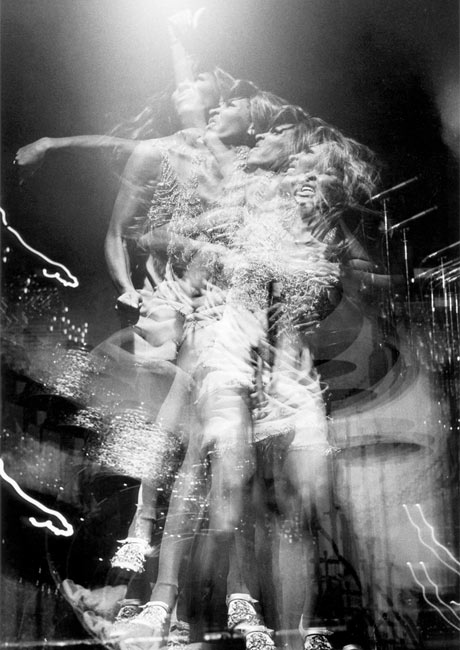 Photograph: Bob Gruen
Photograph: Bob Gruen
A friend of mine was a big fan of Ike and Tina, and suggested I come to a show at the Honka Monka Room in Queens. I had no idea I was going to get a good picture, it was just for my memory. I was sitting on the floor and a strobe light was flashing. I thought I'd try a long exposure. This one picture caught Tina in five different expressions. It captures the energy that is Tina Turner.
A few days later we went to another show. I'd brought the pictures from the Honka Monka Room to show my friends and then Ike Turner came walking by. My friend said, "Show Ike the pictures." He liked them and took me to the dressing room to meet Tina. About a year later my first album cover was for Ike and Tina's 'Nuff Said.
I still know Tina. I photographed her all through the 80s. She is unique, one of the originals, top of my list of women who can rock.
Guy Webster: The Mamas & the Papas, 1966
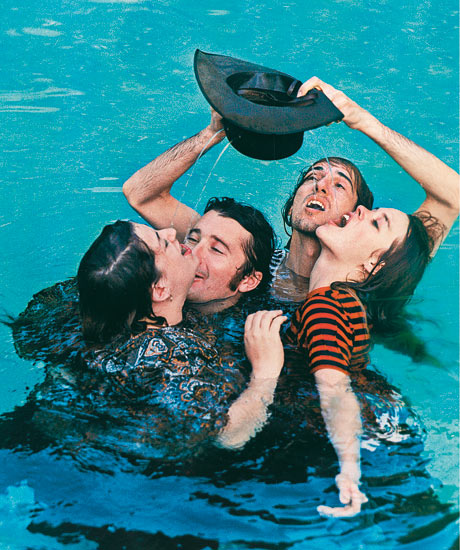 Photograph: Guy Webster
Photograph: Guy Webster
I was one of the early rock photographers, if not the first. I shot theRolling Stones, the Byrds, Procol Harum, the Doors, Carole King, Simon & Garfunkel. I nicknamed them the kids in the candy store. They got rich overnight; they had all the money and all the toys, but they didn't know how to handle it. I watched the Beach Boys, who were friends of mine, buy a Ferrari and crash it on the same day.
I'd worked with the Mamas & the Papas from the start, but when I took this shot they were beginning to argue. There was a lot of tension – over sexual stuff and business stuff. The truth is that while Denny was the great singer and Cass had the belting voice, it was John and Michelle Phillips who were making the money because they owned the rights. This was taken at their Bel Air mansion.
Michelle and Denny had also had an affair. Michelle had married an older man but she was young and beautiful and guys in other bands were always coming on to her. It was a time of free love. Denny was her chance to have some fun.
That day I had to get everyone together and looking like they still liked each other. It was late in the evening – maybe 6pm – and I was worried that there wasn't going to be enough light. I got them in the pool, put holes in John's hat and we had a picture. When you're shooting rock'n'roll you can't keep them long, their attention span is very short. For me this photograph captures the spirit of the time: love, togetherness and joyfulness.
Anton Corbijn: U2, 1986
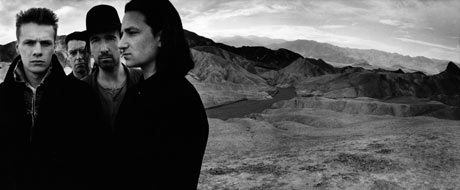 Photograph: Anton Corbijn
Photograph: Anton Corbijn
I'd been working with U2 for four years when we did this picture. The working titles for their new album were "the two Americas" and "desert songs", so I went looking for deserts in California. The shots which include the actual Joshua Tree were shot in Death Valley, the cover shot was at Zabriskie Point. The tree is named after the biblical Joshua. I suggested it to Bono, and he came back the next morning with a bible in his hand saying we'd go for it.
I came to England from Holland in the late 70s and started working for the NME. The interesting thing is that the two groups I'm most associated with – Depeche Mode and U2 – are both bands I was not a fan of at first. I turned Depeche Mode down for five years because I thought they were too poppy. With U2, they were playing on a boat moored on the Mississippi and I thought, "OK, I'll listen to a couple of songs just to prove I was there then I'll leave." I didn't realise the boat would set off, so I had to stay for the gig. I liked the guys and ended up travelling with them and did more pictures. It was the beginning of a friendship.
When the Joshua Tree album came out and became so big I felt very removed from it. I looked at the billboards and it didn't feel like the little picture I printed in my dark room. It became this other thing.
Photographing U2 has become more difficult as they have become more well known. The Joshua Tree was taken over a period of three days travelling through the desert. It's unthinkable for U2 to do that now. For their last album I had two hours in bad weather.
Even after 28 years I always try to take a different picture of U2. If I'm stuck, I'll go to Holland, smoke a joint and come back with new ideas.
• All photographs from Who Shot Rock & Roll, by Gail Buckland, published by Knopf, at £28.99, from turnaround-uk.com. To order a copy for £26.99, with free UK p&p, go to guardian.co.uk/bookshop or call 0330 333 6846.

No comments:
Post a Comment